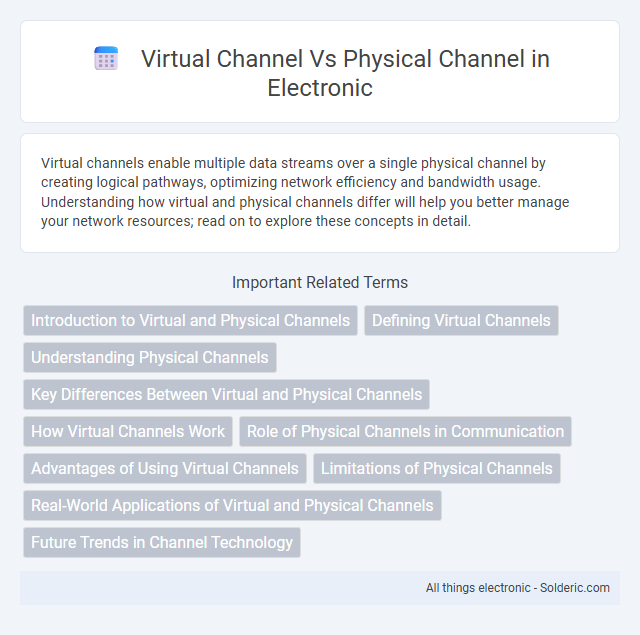Virtual channels enable multiple data streams over a single physical channel by creating logical pathways, optimizing network efficiency and bandwidth usage. Understanding how virtual and physical channels differ will help you better manage your network resources; read on to explore these concepts in detail.
Comparison Table
| Aspect | Virtual Channel | Physical Channel |
|---|---|---|
| Definition | A logical communication path established over a network. | The actual physical medium used to transmit data. |
| Layer | Data link or network layer. | Physical layer. |
| Examples | VPN tunnels, VLANs, MPLS paths. | Ethernet cables, fiber optics, wireless signals. |
| Function | Enables multiplexing and logical separation of data. | Transfers raw bits over the medium. |
| Flexibility | Highly flexible; can be configured and changed in software. | Fixed physical infrastructure. |
| Bandwidth Sharing | Shares underlying physical channel bandwidth. | Owns dedicated transmission capacity. |
| Error Handling | Handles errors via protocols like HDLC or MPLS. | Minimal error handling; relies on higher layers. |
Introduction to Virtual and Physical Channels
Virtual channels refer to logical communication pathways that share a single physical medium, enabling multiple data streams to coexist without interference. Physical channels represent the actual hardware-based transmission paths, such as cables or frequency bands, used to carry signals in a network. Understanding the distinction between virtual and physical channels is crucial for optimizing network resource allocation and improving data transmission efficiency.
Defining Virtual Channels
Virtual channels are logical pathways within a physical communication channel that enable multiple data streams to be transmitted simultaneously, optimizing bandwidth usage and network efficiency. Unlike physical channels, which consist of tangible hardware components like cables or radio frequencies, virtual channels exist as software-defined tunnels that separate and manage data flows independently. Your network can leverage virtual channels to ensure smoother data transmission and reduce congestion without altering the physical infrastructure.
Understanding Physical Channels
Physical channels represent the actual radio frequency bands or time slots used in wireless communication to transmit data between devices. These channels handle the raw signal transmission and are defined by specific frequency ranges, bandwidth, and modulation schemes. Understanding physical channels is crucial for optimizing network performance, avoiding interference, and ensuring reliable data transfer in systems like LTE and 5G NR.
Key Differences Between Virtual and Physical Channels
Virtual channels operate by multiplexing multiple logical channels over a single physical medium, enabling efficient bandwidth use and flexible data routing. Physical channels refer to the actual hardware or frequency bands that carry signals, providing the tangible infrastructure for transmission. Understanding the distinction helps you optimize network design by leveraging virtual channels for scalability while relying on physical channels for robust connectivity.
How Virtual Channels Work
Virtual channels operate by creating logical pathways over a single physical channel, enabling efficient data transmission and management. Your device assigns unique identifiers to each virtual channel, allowing multiple data streams to coexist without interference while sharing the same physical infrastructure. This method optimizes bandwidth utilization and enhances communication flexibility within networks.
Role of Physical Channels in Communication
Physical channels serve as the actual medium through which data is transmitted in communication systems, including wired cables, fiber optics, and wireless frequencies. They provide the tangible infrastructure that enables the transmission of signals, converting digital information into electrical, optical, or radio waves for propagation. The performance and reliability of communication networks heavily depend on the physical channel's characteristics such as bandwidth, noise, and attenuation.
Advantages of Using Virtual Channels
Virtual channels enable efficient resource utilization by allowing multiple data streams to share a single physical communication link, increasing bandwidth efficiency and reducing hardware costs. They provide enhanced flexibility in network management, enabling dynamic allocation and prioritization of data flows based on real-time demands. Virtual channels also improve fault isolation and security by segregating traffic, minimizing the risk of congestion and enhancing quality of service (QoS) for critical applications.
Limitations of Physical Channels
Physical channels are limited by their fixed frequency allocation and bandwidth capacity, restricting the number of simultaneous transmissions and overall data throughput. These constraints can cause interference and signal degradation, especially in congested environments or over long distances. Understanding these limitations helps you appreciate the flexibility and efficiency offered by virtual channels in modern communication systems.
Real-World Applications of Virtual and Physical Channels
Virtual channels enable efficient data transmission in networking by allowing multiple logical communication paths over a single physical link, optimizing bandwidth use in applications like IPTV and VoIP. Physical channels represent actual hardware connections, crucial in wired and wireless telecommunication infrastructures for reliable signal delivery in cellular networks and broadband. Your choice between virtual and physical channels impacts system scalability and resource management in real-world scenarios such as network virtualization and channel multiplexing.
Future Trends in Channel Technology
Future trends in channel technology emphasize the integration of virtual channels with physical infrastructure to enhance network efficiency and scalability. Technologies like 5G and software-defined networking (SDN) enable dynamic allocation of virtual channels over physical spectrum resources, optimizing bandwidth utilization and reducing latency. The evolution towards cloud-native and AI-driven channel management systems promises more adaptive and resilient communication networks, facilitating seamless user experiences across diverse applications.
Virtual Channel vs Physical Channel Infographic

 solderic.com
solderic.com